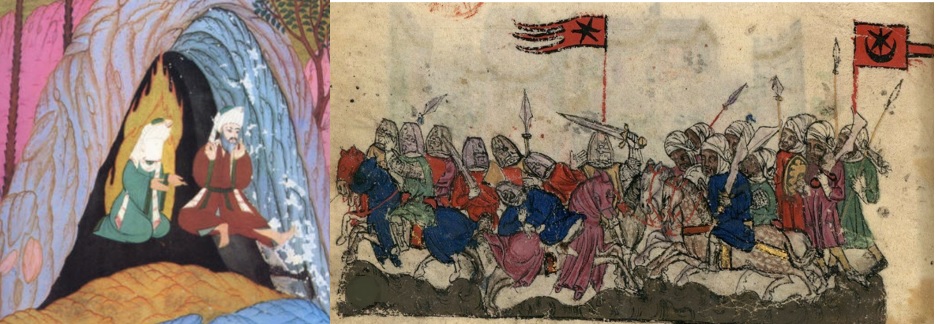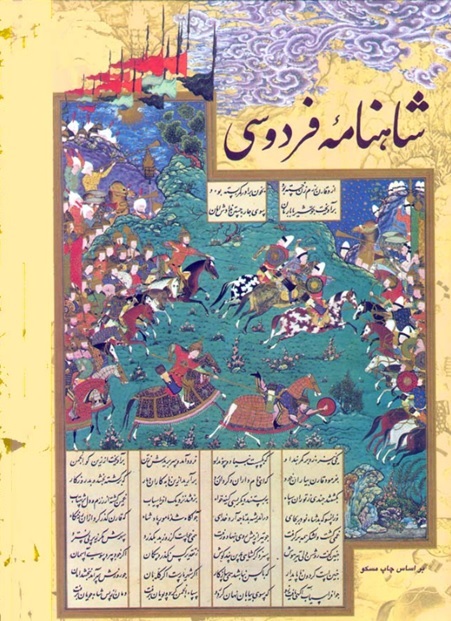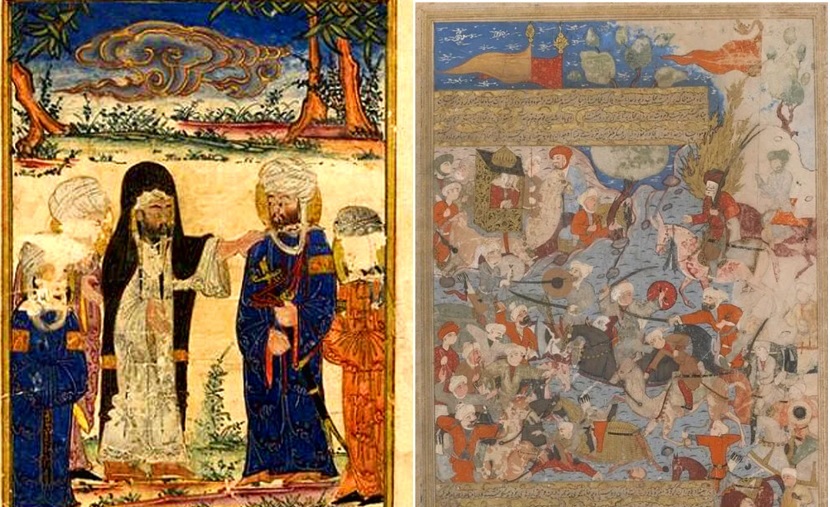25 Muhammad and the Rashidun Caliphate (No. 2)

初代正統カリフ・アブー・バクル
First Rashidun Caliph Abu Bakr
初代正統カリフ就任
アブー・バクル・スィッディーク(c. 573~634)は、ムハンマドの最初の入信者の1人であり、ムハンマドの教友でもありました。クライシュ族タイム家(Banu Taym) (بنو تيم)の出身で、ムハンマドの親戚筋でもあります。その娘アーイシャ(Aisha bint Abu Bakr) (612~678) (عائشة بنت أبي بكر) はムハンマドのもっとも寵愛した妻であり、戦いにもムハンマドに連れ添いました。632年に預言者ムハンマドが死去した後、ウンマ共同体の指導者選定ではもともとのマディーナ住民アンサールの強い抵抗がありました。しかしながらウマル・イブン・ハッターブ(592~644)の推挙もあったので、アブー・バクルは、バイア(Bay’ah) (بيعة)(忠誠の誓い)を受けて「神の使徒ムハンマドの代理人カリフ」を名乗り、初代正統カリフ(632~634)に就任しました。
Abu Bakr proclaimed himself Caliph
Abu Bakr Siddiq (c. 573~634) was one of Muhammad’s first followers and a companion of Muhammad. He is from Banu Taym (بنو تيم) (a clan of the Quraysh tribe) and is a relative of Muhammad. His daughter Aisha bint Abu Bakr (612~678) (عائشة بنت أبي بكر) was Muhammad’s most beloved wife and accompanied him even in a battle. After the death of the Prophet Muhammad in 632, the selection of the leaders of the Ummah community was met with the strong resistance from Ansar (the Madinah resident). However, at the suggestion of Umar ibn Khattab (592~ 644), Abu Bakr accepted the Bay’ah (بيعة) (Oath of Allegiance) and proclaimed himself “the caliph, the representative of Muhammad, the messenger of God”, and became the first Rashidun (orthodox) caliph (632~634).
入信者の棄教の動き
アブー・バクルが就任した直ぐ後に新しい共同体と国家の統一と安定を脅かす問題が発生しました。棄教は、ムハンマドの生前から起きてはいたものの、一応は収まっていました。しかしながら、もっとも深刻な棄教は、ムハンマドの死後に起き、入信者の棄教の動きがアラビア中に広がりました。
棄教は、メッカとマディーナおよびターイフのサキーフ族(Thaqif) (ثقيف)を除く、半島の全ての部族に影響するまでに一般的になりました。幾つかの例では部族全体が棄教しています。イスラームへの挑戦としてザカート(Zakat) (زكاة)や慈善税を滞納する者達もいました。多くの部族指導者達は、預言者の地位を要求しました。バヌー ・ハニーファ族(Banu Hanifa) (بنو حنيفة)のムサイリマ(Musaylimah) (مسيلمة)の様な者達は、ムハンマドの生前からすでに預言者を名乗っていました。バヌー ・ハニーファ族(Banu Hanifa) (بنو حنيفة)は、ラビーア族(Rabi’ah) (ربيعة)に属するバクル・イブン・ワーイル族(Bakr ibn Wa’il) (بكر بن وائل)の一門で、ヤマーマ地方(Al-Yamamah) (اليمامة)に拠点を置いました。
Movement of Spreading Apostasy
Shortly after Abu Bakr took office, problems arose that threatened the unity and stability of the new community and state. Although Apostasy had occurred during Muhammad’s lifetime, it had subsided for the time being. However, the most serious Apostasy occurred after Muhammad’s death, and the movement of Apostasy spread throughout Arabia.
Apostasy became common to the point of affecting all the tribes of the Arabian Peninsula, except Mecca, Madinah and Thaqif (ثقيف) of Taif. In some cases, entire tribes have apostatized. Some tribes challenged Islam by delinquent in zakat (زكاة) and charity taxes. Many tribal leaders demanded a prophet position. Some, such as Musaylimah (مسيلمة) of Banu Hanifa (بنو حنيفة), had already proclaimed himself a prophet during Muhammad’s lifetime. Banu Hanifa (بنو حنيفة) is a clan of Bakr ibn Wa’il (بكر بن وائل), belonging to Rabi’ah (ربيعة) tribe. Banu Hanifa had based in Al-Yamamah region (اليمامة).
リッダの戦い(棄教の戦い)
多くの部族が「自分達の服従はマハンマドに対してであり、ムハンマドの死で忠誠は終わった。」と主張しました。アブー・バクルは、「これら部族に対してムハンマドに服従しただけでは無く、アブー・バクル自身が新しい長となったムスリムの宗教共同体に参加していた。」のだと主張しました。棄教は、イスラーム法の伝統的解釈では死刑に値する罪であり、アブー・バクルは、反逆者達に対して戦争を宣言しました。
これが「リッダの戦い(棄教の戦い)(Ridda Wars or Wars of Apostasy) (632~633) (حروب الردة) 」あるいは「棄教の戦い」の始まりでした。半島中央部の棄教者達は、自称預言者ムサイリマに率いられました。その他の中心となったのはバハレイン(Bahrain) (البحرين)の南と東、オマーン、マフラ(Mahra) (المهرة)(イエメンのオマーン国境)およびイエメンでした。アブー・バクルは、それらに対応して作戦を立てました。アブー・バクルは、ムスリム軍を幾つかのグループに分けました。
最強のムスリム軍主力は、ムダル族バヌー キナーナ族の支族クライシュ族の主要な3つ一門の1つバヌー・マフズウム家(Banu Makhzum) (مخزوم بنو)の出で、「アッラーの剣」との異名で知られるハーリド・イブン・ワリード(Khalid bin Al Walid) (592~642) (الوليد بن خالد)の率いる部隊でした。この部隊は、叛乱軍のもっとも強力な相手と戦うのに使われました。その他のグループは、棄教部族でも余り危険では無い相手に対する第二次的に重要な地域に割り当てられました。アブー・バクルの作戦は、先ずマディーナに近い半島西部および中央部を一掃し、それから次にアドナーン部族ムダル族支族でクライシュ族の兄弟部族バニー・タミーム族(Bani Tamim) (بني تميم)、バニー・ヤルブウ(Bani Yarbu’) (بني يربوع)一門の首長マーリク・イブン・ヌワイラ(Malik ibn Nuwayrah) (مالك بن نويرة)を捕捉し、そして最後にもっとも危険な敵ムサイリマに立ち向かうと云うものでした。
Ridda Wars (Wars of Apostasy)
Many tribes claimed that their submission was to Mahammad, and that their allegiance ended with Muhammad’s death. Abu Bakr claimed that “they submited not only to Muhammad, but also joined the Muslim religious community, of that Abu Bakr took himself the place of the new head.” Apostasy is a capital offense under the traditional interpretation of Islamic law, and Abu Bakr declared war on his rebels.
This was the beginning of the Ridda Wars or Wars of Apostasy (632~633) (حروب الردة). The apostates of the central peninsula were led by the self-proclaimed prophet Musaylimah. Other centres were the south and east of Bahrain (البحرين), Oman and Mahra (المهرة) (Yemen’s Omani border) and Yemen. Abu Bakr made his plans in his response to them. Abu Bakr divided the Muslim army into several groups.
The main force of the strongest Muslim army was led by Khalid bin Al Walid (592~642) (الوليد بن خالد). Khalid bin Al Walid was from the Banu Makhzum (مخزوم بنو), one of the three main branches of the Quraysh tribe of the Banu Kinana tribe, and known as the “Sword of Allah”. This main force was used to fight the most powerful opponents of the rebel army. The other forces were assigned to the areas of the secondary importance against the less dangerous apostate tribes. Abu Bakr’s operation first cleared the western and central Arabian Peninsulas near Madinah, and then cleared Malik ibn Nuwayrah (مالك بن نويرة), the chieftain of Bani Yarbu’ (بني يربوع). Bani Yarbu’ belongs to Bani Tamim (بني تميم), a branch of the Adnan Arabs and the brother tribe of Quraysh. And finally it confronted the most dangerous enemy, Musaylima.

イスラームの下にアラビア半島統一
幾つかの戦闘に勝利した後にハーリド・イブン・ワリードは「ヤマーマの戦い(Battle of Yamama) (December, 632) (معركة اليمامة)」でムサイリマを打ち負かせました。棄教者達への軍事行動は、ヒジュラ暦11年 (632)に完了しました。ヒジュラ暦12年(633年3月18日)に「アラビア半島」はマディーナのカリフの中央権力の下に統合されました。スンニー派の伝承によればこれらの大きな叛乱を鎮めてベドウィン部族の競合する預言者達を打ち破ったことでアブー・バクルは、「アラビア半島」の残りをイスラームの下に結束させ、本質的にイスラームを救う事が出来ました。
Unity of Arabian Peninsula under Islam
After winning several battles, Khalid ibn Walid defeated Musaylimah in the Battle of Yamama (معركة اليمامة) (December 632). The military campaign against the apostates was completed in the 11th year of the Hijri calendar (632). In the 12th year of the Hijri calendar (March 18, 633), the “Arabian Peninsula” was consolidated under the central authority of the Caliph of Madinah. According to Sunni tradition, by quelling these great rebellions and defeating the rival prophets of the Bedouin tribes, Abu Bakr was able to unite the rest of the “Arabian Peninsula” under Islam and essentially save Islam.
イスラームの征服開始
叛乱を鎮圧すると、直ぐにアブー・バクルは、征服戦争を始めました。アブー・バクルは、先ずサーサーン朝ペルシア帝国(224~651)のもっとも豊かなイラク州征服から始めました。633年にアブー・バクルは、才気縦横な将軍ハーリド・イブン・ワリードをペルシア帝国に侵攻させました。アブー・バクルは、それから4軍団をローマ領シリアに侵攻させ、さらにイラク征服を終えたハーリド・イブン・ワリードを投入して決定的な戦闘を行いました。しかしながら、アブー・バクルは、征服戦争の途上でカリフ在位わずか2年にして病のため亡くなりました。
Beginning of Muslim Conquests
As soon as the rebellion was suppressed, Abu Bakr began the Muslim Conquests (the Islamic Conquest). Abu Bakr started with attacking the Iraq province, the richest one under the rule of Sassanid Persian Empire’s (224~651). In 633, Abu Bakr ordered the brilliant general Khalid ibn Walid to conquer Persian Empire. Abu Bakr then ordered four legions to invade into Roman Syria and sent Khaled ibn Walid after his conquest of Iraq to wage a decisive battle. However, Abu Bakr died of illness in the middle of the Muslim conquest, after only two years as the caliph.
アブー・バクル治世下での主な戦役
| リッダ戦争(棄教の戦い) | 632~633年 | ムスリム軍勝利 |
| 戦場:2聖都及びターイフを除く「アラビア半島」全域 | 敵軍: ベドウィン部族の競合する預言者達 | ムスリム軍:ワリード率いるムスリム軍主力部隊 |
| 戦果:アラビア半島がカリフ中央権力下に統合 | 競合する預言者達を打破 | イスラーム下での結束 |
| ヤマーマの戦い | 633年 | ムスリム軍の決定的勝利 |
| 戦場: リヤード近郊ウヤイナのアクラバー平原 | 敵軍: ムサイリマ指揮下の棄教者4万人 | ムスリム軍:ハーリド・イブン・ ワリード率いる2万1千人 |
| 戦果:リッダの戦い(棄教の戦い)の勝利 | ||
| フィラードの戦い(フィーラズの戦い) | 634年1月 | ムスリムの決定的勝利 |
| 戦場: メソポタミアのフィーラズ | 敵軍: ビザンチン、サーサーン、キリスト教徒連合10~15万人 | ムスリム軍: ハーリド・イブン・ワリード率いる1万5千人 |
| 戦果: メソポタミア全域をイスラーム帝国領に編入 | ||
| ボスラの戦い | 634年6~7月 | ムスリムの勝利 |
| 戦場: シリアのボスラ | 敵軍: ビザンチン帝国とガッサーン朝連合軍1万2千人 | ムスリム軍: ハーリド・イブン・ワリード率いる1万3千人 |
| 戦果:降伏 |
Major campaigns under Reign of Abu Bakr
| Ridda Wars (Wars of Apostasy) | 632~633AD | Victory of Muslim army |
| Battlefield: Entire Arabian Peninsula, except for 2 holy cities and Taif | Enemy forces: Other Bedouin prophets competing against Muhammad | Muslim army:Muslim main army led by Khalid bin al-Walid |
| Battle Results: Arabian Peninsula was united under Central authority of Caliphate. | Defeated Other Bedouin prophets competing against Authority of Caliphate. | Established solidarity under Islam. |
| Battle of Yamama (A part of the Ridda Wars) | December 633 AD | Decisive victory of Muslim army |
| Battlefield: Plain of Aqraba of Uyaynah near Riyadh | Enemy:40,000 apostates under Musaylimah ibn Habib (self-proclaimed prophet) | Muslim army:Muslim main army of 21,000 men led by Khalid bin al-Walid |
| Battle Results: Winning Battle of Ridda | ||
| Battle of Firaz | January 634 AD | Decisive victory of Muslim army |
| Battlefield: Firaz, Mesopotamia (Iraq) | Enemy forces:Combined forces of Byzantine and Sassanid Empires of 100,000~150,000 mens | Muslim army:Muslim army of 15,000 men led by Khalid bin al-Walid |
| Battle Results: Transferred entire Mesopotamia into Islamic Empire | ||
| Battle of Bosra | June–July 634 AD | Victory of Muslim army |
| Battlefield: Bosra, Syria | Enemy forces: Combined forces of Byzantine and Sassanid Empires of 12,000mens | Muslim army:Muslim army of 13,000 men led by Khalid bin al-Walid |
| Battle Results: Combined forces surrender |
第二代正統カリフ・ウマル・イブン・ハッターブ
Second Rashidun Caliph Umar ibn Khattab
第二代正統カリフに就任
ウマル・イブン・ハッターブは、預言者の親戚であり、初代正統カリフのアブー・バクルの没後に第二代正統カリフ(634~644)に就任しました。ウマルは、クライシュ族のバヌー・アディー(Banu Adi) (بنو عدي)支族に属し、若い頃は、武勇に優れた勇士として知られていました。スンニー派教徒には「真実と虚偽を判断する人」を意味するウマル・ファールーク(Omar al Faruq) (عمر الفاروق)と呼ばれ、オマルあるいはウマルと転写されています。
610年頃にウマルは、クライシュ族の伝統的信仰を守る立場からムハンマドの布教活動を迫害する側に回り、ムハンマドを殺そうとしました。しかしながら、クルアーンの章句に心を動かされて改悛し、イスラームに帰依しました。632年にムハンマドが死去すると、アブー・バクルを後継指導者に推戴してカリフの地位を帯びてイスラーム共同体を指導する慣行のきっかけをつくりました。アブー・バクルが2年後に死去すると、その後継者に指名されて第二代目のカリフとなりました。
Inaugurated Second Rashidun Caliph
Umar ibn Khattab was a relative of the Prophet and was inaugurated the second Rashidun Caliph (634~644) after the death of Abu Bakr, the first Rashidun Caliph. He belonged to the Banu Adi (بنو عدي) branch of the Quraysh tribe, and was known as a warrior of great valor in his youth. Sunnis called him Omar al Faruq (عمر الفاروق), which means “one who judges truth and falsehood” and is transcribed as Omar or Umar.
Around 610, Umar, defending the traditional beliefs of the Quraysh, sided with the persecutors of Muhammad’s missionary activities and tried to kill Muhammad. However, he was moved by the verses of the Qur’an and repented and converted to Islam. After Muhammad’s death in 632, Abu Bakr was appointed as his successor leader, setting the stage for the practice of leading the Islamic community with the position of caliph. When Abu Bakr died two years later, he was appointed as his successor and became the second caliph.
イスラームの征服推進
アブー・バクルは、ウマルが自分の後継者となることを望み、ムハンマドの有力な信者達の多くをその様に説得しました。ウマルは、軍事と政治の両方に非凡な才能を持っていました。ウマルは、「アラビア半島」のアラブの統一を背景に多方面に遠征軍を送り出して、アブー・バクルの始めた征服戦争「ムスリムの征服(イスラームの征服)(Muslim Conquests) (الفتوحات الإسلامية)」(ムハンマド時代(622~632)、正統カリフ時代(632~661)、ウマイヤ朝時代(661~750))を継続して指導しました。ウマルはサーサーン朝ペルシア帝国(224~651)自体を攻め立てたる一方でシリアとビザンチン帝国領および西エジプトにも進撃しました。これらの地方は、強力な国家に守られて世界でもっとも豊かな地域もありましが、長引いたローマ・ペルシア戦争(Roman-Persian Wars) (54 BC~628) (682 years) (Byzantine–Sasanian wars (285~628))の後なので両国とも疲弊していました。イスラーム軍は、またたく間にサーサーン朝ペルシア帝国(224~651)とビザンチン帝国(395~1453)を圧倒しました。640年までにイスラーム軍は、メソポタミア、シリアおよびパレスチナをイスラーム帝国の支配下に置きました(Muslim conquest of the Levant (634~638))。さらにエジプトを征服し(Muslim conquest of Egypt (639~646))、サーサーン朝ペルシア帝国全域を奪い取りました(Muslim conquest of Persia (633~654))。
Promotion of Muslim Conquests
Abu Bakr wanted Umar to be his successor and persuaded many of Muhammad’s influential followers to do so. Umar had extraordinary talents in both military and politics. On the background of the Arab unity of the Arabian Peninsula, Umar sent expeditionary forces in various directions continuously to lead “Muslim Conquests” (الفتوحات الإسلامية) ,initiated by Abu Bakr. Muslim Conquests continued during Muhammad era (622~632), Rashidun caliphates era (632~661) and the Umayyad period (661~750). Umar attacked Sassanid Persian Empire (224~651) itself, while also advanced into Syria, the Byzantine territories, and the western Egypt. These regions were protected by the powerful states and were some of the richest in the world, but because of the protracted Roman-Persian Wars (54 BC~ 628) (682 years) (Byzantine–Sasanian wars (285~628)) the both empires were exhausted. The Islamic army quickly overwhelmed Sassanid Persian Empire (224~651) and Byzantine Empire ( 395~1453). By 640, Islamic forces had placed Mesopotamia, Syria and Palestine under the control of Islamic Empire (Muslim Conquest of the Levant (634~ 638)). They also conquered Egypt (Muslim Conquest of Egypt (639~646)), and done the entire Sassanid Persian Empire (Muslim Conquest of Persia (633~ 654)).

政治および財務基盤の確立
ウマルの治世下でイスラーム帝国は、目覚しい速さで拡大しました。その一方でウマルは、それが一体と成るような政治機構の基礎も築き創めました。ウマルは、非ムスリムの者達にイスラームへ改宗する事を要求しなかったし、ペルシアの様に中央集権国家を創ろうともしませんでした。代わりにウマルは、隷属民達に宗教、言語、習慣および政権を比較的もとのまま保つ事を容認しました。唯一任命したのが総督(アミール(Amir) (أمير))と財務官(アーミル(‘Amil) (عامل))でした。
ウマルの遠大な改革は、イスラーム帝国の為に財務体制を築く事にありました。ウマルは、イスラーム帝国のもっとも重要な側面が政府の安定した財務体制である事を理解していました。徴税の効率的な体制を築き、そして軍隊を直接、国家の財務支配下に取り込みました。ウマルは、イスラームの特異な制度であるディーワーン(Diwan) (ديوان)も創設しました。ディーワーンはムハンマドの教友達の様なイスラーム信仰およびイスラーム世界で重要な個人で構成されました。信仰への貢献は、生活費を賄う年金が与えられる程に大きいものでした。この年金は、これらの個人が宗教的そして道徳的研究を追及し、イスラーム世界の人々への精神的な指導力を培うのに十分な金額でした。こうして歴史上の偉大な天才政治家の1人であるウマルは、アラブ人主体のアラブ帝国またはサラセン帝国(Caliphate) (الخلافة الإسلامية)とも呼ばれるイスラーム帝国の初期国家体制を確立しました。
Establishing Political & Financial Foundations
Under Umar’s reign, Islamic Empire expanded at an impressive rate. On the other hand, Umar also laid the foundations for a political structure in which it would come together. Umar did not require non-Muslims to convert to Islam, nor did he seek to create a centralized state like Persia. Instead, Umar allowed the pagans, whoever came into under his rule, to keep their religion, language, customs, and regime relatively intact. The only appoints were the Governor (Amir) (أمير) and the Treasurer (‘Amil) (عامل).
Umar’s far-reaching reforms led to the establishment of the financial system for Islamic Empire. Umar understood that the most important aspect of Islamic Empire was the government’s stable financial system. It established an efficient system of tax collection and brought the military directly under the financial control of the state. Umar also founded Diwan (ديوان), a peculiar institution of Islam. The Diwan consisted of important individuals in the Islamic faith and the Islamic world, such as Muhammad’s friends. Their contribution to the faith was so great that they were given a pension for each to cover their living expenses. This pension was sufficient for these individuals to pursue religious and moral studies and to cultivate spiritual leadership over the people of the Islamic world. Thus, one of the greatest genius politicians of history, Umar was the creator of Arab-dominated Arab Empire or Saracen Empire (Caliphate) (الخلافة الإسلامية). It also known as Islamic Empire, which Umar established the initial state system.
イスラーム暦とイスラーム法の確立
ウマルは、クルアーンを照合する手順を含め、多くのイスラームの慣例も確立しました。ウマルが確立し、今でも使われている慣例としてはイスラーム暦があります。アラビア暦と同じ様に太陰暦ですが、ウマルは、暦の初めをムハンマドがマディーナに聖遷した年に合わせ、ヒジュラ(هجرة) (Hijra)紀元(聖遷622年7月16日)を定めました。さらにクルアーンとムハンマドの言行に基づいた法解釈を整備して後の時代にイスラーム法(シャリーア(Shar’a or Shariah) (شريعة))にまとめられる法制度を準備しました。
Establishing Hijra Calendar & Shariah Law
Umar also established many Islamic practices, including the procedure for collating the Qur’an. An example of a practice established by Umar and still in use is the Islamic calendar. Like the Arabic calendar, it is a lunar calendar, but Umar coincides the beginning of the calendar with the year of Muhammad’s consecration to Madinah, and the Hijra (July 16, 622). In addition, he developed a legal interpretation based on the words and deeds of the Qur’an and Muhammad, and prepared a legal system that would be compiled into Islamic law (Shar’a or Shariah (شريعة)) in later times.
暗殺未遂とカリフ候補
ウマルは、644年に朝の祈りの間にペルシア人奴隷アブー・ルウルウ・フィールーズ(Abu Lulu Fieroz) (أبو لولو فيروز)の暗殺企てで瀕死の重傷を負いました。死亡する前にウマルは、次期カリフ候補として6名を選び、カリフを互いの合議で決めるように指名しました。
Assassination Attempt and Caliph Candidates
Umar was mortally wounded in 644 in an assassination attempt by the Persian slave Abu Lulu Fieroz (أبو لولو فيروز) during morning prayers. Before his death, Umar selected six candidates to be the next caliphate and nominated them to be decided by mutual consultation.
ウマル治世下での主な戦役
| 橋の戦い(ジスルの戦い) | 634年10月 | サーサーン朝の勝利 |
| 戦場: クーファ付近のユーフラテス川 | 敵軍: バフマン指揮下サーサーン朝軍1万人 | ムスリム軍: アブー・ウバイド率いる9千人 |
| 戦果:イスラーム帝国に対するサーサーン朝唯一の勝利 | ||
| ヤルムークの戦い | 636年8月15~20日 | 勝敗:アブー・ウバイダの勝利 |
| 戦場:シリアのヤルムーク川付近 | 敵軍: ビザンチン帝国とガッサーン朝連合軍 | ムスリム軍: ハーリド・イブン・ワリード等の指揮 |
| 戦果: レヴァントをイスラーム帝国領に編入 | ガッサーン朝崩壊 | |
| カーディシーヤの戦い | 636年11月16~19日 | ムスリムの決定的な勝利 |
| 戦場: イラクのカーディシーヤ(クーファ南西) | 敵軍: サーサーン朝軍6万人 | ムスリム軍:サアド・イブン・アビー・ワカース等が率いる3万人 |
| 戦果: イラクをイスラーム帝国領に編入 | ||
| イスラームのペルシア征服 | 633~654年 | ムスリムの勝利 |
| 敵: メソポタミア、コーカサス、ペルシア、ホラーサーン | 敵: サーサーン朝、ビザンチン、アラブキリスト教徒同盟 | ムスリム軍: カリフ・アブー・バクル、カリフ・ウマル |
| 戦果: メソポタミアとサーサーン朝ペルシア全土をイスラーム帝国領に編入 | ||
| アナトリア占領 | 637~654年 | ムスリムの勝利 |
| 戦場: アナトリア | 敵軍: ビザンチン帝国軍 | ムスリム軍:アブー・ウバイダ、ワリード、イヤード・イブン・ガニム等が指揮 |
| 戦果: タウロス山脈までのアナトリアをイスラーム帝国領に編入 | ||
| エジプト征服 | 639~642年 | ムスリムの勝利 |
| 戦場: エジプト、リビア等 | 敵軍: ビザンチン帝国軍 | ムスリム軍: カリフ・ウマル |
| 戦果: エジプト、東リビア、西リビア海岸、西リビア内陸をイスラーム帝国領に編入 | ||
| ニハーヴァンドの戦い | 642年 | ムスリムの決定的勝利 |
| 戦場: イラン ハマダーン付近のニハーヴァンド | 敵軍: バフマン等指揮の10~15万人 | ムスリム軍: ムクリン率いる3万人 |
| 戦果: サーサーン朝滅亡 | ||
Major campaigns under the reign of Umar
| Battle of Jisr(Battle of Bridge) | October 634 AD | Sassanid victory |
| Battlefield: Euphrates near Kufa, Iraq | Enemy forces: Sassanid forces of 10,000 men led by Bahman Jaduya | Muslim army:9,000 men led by Abu Ubayd |
| Battle Results: only major Sassanian victory over Rashidun Caliphate | ||
| Battle of Yarmouk | August 15~20, 636 AD | Abu Ubaidah’s victory |
| Battlefield: Near Yarmuk River, in Syria | Enemy forces: Combined forces of Byzantine Empire and Ghassanids of 15,000~150,000 men | Muslim army:15,000~40,000 men led by Khalid bin al-Walid, etc. |
| Battle Results: Transfered Levant into the Islamic Empire | Ghassanids collapsed in 638 AD | |
| Battle of al-Qadisiyyah | November 16~19, 636 AD | Decisive victory of Muslim army |
| Battlefield: Al-Qadisiyyah in southwest of Kufa, Iraq | Enemy forces: Sassanid forces of 60,000 men | Muslim army:30,000 men led by Sa’d ibn Abi Waqqas, etc. |
| Battle Results: Transfered Iraqt into the Islamic Empire | ||
| Muslim conquest of Persia | 633~654 AD | Victory of Muslim army |
| Battlefield: Mesopotamia, Caucasus, Persia, Khorasan、etc. | Enemy: Byzantine & Sassanid Empires and Arab Christian League | Muslim army:Under Abu Bakr’s reign and Umar’s reign |
| Battle Results: All of Mesopotamia and Sassanid Persia were incorporated into Islamic Empire. | ||
| Occupation of Anatolia | 637~654 AD | Victory of Muslim army |
| Battlefield: Anatolia | Enemy forces: Byzantine imperial army | Muslim army:Led by Abu Ubaidah, Khalid ibn al-Walid, Iyad ibn Ghanm, etc. |
| Battle Results: Anatolia up to Taurus Mountains was incorporated into Islamic Empire territory. | ||
| Conquest of Egypt | 639~642 AD | Victory of Muslim army |
| Battlefield: Egypt, Libya, etc | Enemy forces:Byzantine imperial army | Muslim army:4,000 men led by Amr ibn al-As and |
| Battle Results: Egypt, East Libya, West Libyan coast, and West Libyan interior were incorporated into Islamic Empire. | reinforced by 12,000 men in 640 later. | |
| Battle of Nihavand | 642 AD | Decisive victory of Muslim army |
| Battlefield: Nahavand, near Hamadan, Iran | Enemy forces: Sassanid forces of 100,000~150,000 men led by Bahman Jadhuyih, etc. | Muslim army:30,000 men led by An-Numan ibn Muqarrin, etc. |
| Battle Results: Near collapse of Sassanid Empire | ||
第三代正統カリフ・ウスマーン・イブン・アッファーン
Third Rashidun Caliph Uthman ibn Affan
第三代正統カリフに選任
第三代正統カリフ(644~656)ウスマーン・イブン・アッファーンは、ウマイヤ家(Umayyad Family) (بنو أمية)の出身でした。ウマイヤ家は、クライシュ族の支族バヌー・アブド・マナーフ氏族(Banu Abd Manaf) (بنو عبد مناف)のバヌー・アブド・シャムス一門(Banu Abd Shams) (بنو عبد شمس)に帰属しています。バヌー・アブド・マナーフ一門(Banu Abd Manaf)は、かつてはムハンマドと激しく対立していましたが、ウスマーンは、バヌー・アブド・マナーフ一門(Banu Abd Manaf)の中では最初にイスラームに改宗しました。預言者ムハンマドの娘ルカイヤ(Ruqayyah bint Muhammad) (رقية بنت محمد)と結婚しましたが、先立たれたので、その妹ウンム・クルスーム(Umm Kulthum bint Muhammad) (أم كلثوم بنت محمد)と再婚しました。
ウマルの後継カリフ選任の為のウマルに指名された次期カリフ候補からなる6人委員会は、全員がクライシュ族出身のムハージルーンでした。このことから元々のマディーナの住民であるアンサールが権力から締め出されていた様子がわかります。微妙な判断ではありましたが、ウスマーンが6人委員会でカリフに選任されました。
Elected Third Rashidun Caliph
The third Orthodox Caliph (644-656) Uthman ibn Affan was from Umayyad Family (بنو أمية). Umayyad family belongs to Banu Abd Shams (بنو عبد شمس) of Banu Abd Manaf (بنو عبد مناف) clan of Quraysh tribe. Uthman was the first person among Banu Abd Manaf clan to convert to Islam, although Banu Abd Manaf clan had once been bitterly opposed to Muhammad. He was married to the Prophet Muhammad’s daughter Ruqayyah bint Muhammad (رقية بنت محمد), but after she died, he married her sister Umm Kulthum bint Muhammad (أم كلثوم بنت محمد).
The six-member committee of candidates nominated by Umar to succeed Umar as caliphate were Al-Muhajirun all from Quraysh. This showed how the original inhabitants of Madinah, Al Ansar, were shut out of the power. Although it was a delicate decision, Uthman was elected Caliph by the Committee of Six.
イスラーム征服の戦争継続
ウスマーンは、正統カリフの中でももっとも人望がありましたが、その治世後半には、エジプト人に率いられ、アリーを支持する者達に敵対されました。外部的にはウスマーンはウマルの始めたイスラーム征服の戦争を続けました。正統カリフ軍は、ビザンチン帝国から北アフリカを勝ち取り、イベリア半島の海岸地方を征服する為にスペインを襲い、ロードス島、シシリー島、キプロス島も襲いました。正統カリフ軍は、サーサーン朝ペルシア(226~651)を完全に征服し、その東の国境は、インダス川の下流にまで及びました。
Continuing Muslim Conquest
Uthman was the most popular of Orthodox Caliphs, but later in his reign he was opposed by Ali’s supporters led by Egyptians. Externally, Uthman continued the Muslim Conquests initiated by Umar. Rashidun Caliphate won North Africa from Byzantine Empire and attacked Spain to conquer the coast of the Iberian Peninsula. It also subdued the islands of Rhodes, Sicily and Cyprus. Rashidun Caliphate completely vanquished Sassanid Persia (226~651), and its eastern border extended to the lower reaches of the Indus River.

クルアーンの正典化
ウスマーンは、クルアーンの正典化を行いました。それまでクルアーンは、信者達によって暗誦されていた口述の伝承でしたが、征服戦争によって暗誦者が相対的に減り、外国人がイスラームに入信することでアラビア語の伝承との違いが目立ち始めました。このためウスマーンは、文章および口述の伝承を全て集め、確定した文章を正典として記録させ、聖典クルアーン(Qur’an) (القرآن)を完成させました。
Completed Holy Qur’an as Canons
Uthman canonized the Qur’an. Until then, the Qur’an had been an oral tradition that had been recited by believers, but the wars of conquest led to a relative decrease in the number of reciters, and as the foreigners entered Islam, differences from Arabic traditions began to become noticeable. For this reason, Uthman collected all the texts and oral traditions, recorded the confirmed texts as the canons, and completed the Holy Qur’an (القرآن).
叛徒により殺害
ウスマーンはイスラーム共同体(ウンマ)運営に同族を重用した上に帝国財政を誤りました。それに不満を抱く叛徒の不穏な動きは日を追って険しく成りました。656年に叛徒達はマディーナに入り、暴動を起しました。そして、ウスマーンの家に押し入り、クルアーンを読んでいたウスマーンを殺害しました。
Killed by Rebels
Uthman mishandled the imperial finances by using heavily his clansmen in the management of the Islamic community (ummah). The disturbing movements of the disgruntled rebels grew steeper day by day. In 656 the rebels entered Madinah and rioted. They broke into Uthman’s house and killed Uthman, who was reading the Qur’an.
ウスマーン治世下での主な戦役
| 北アフリカ征服 | 勝敗: 656年の内乱でムスリム軍撤退 | |
| 戦場: 北チュニジアのスフェテュラ(647)等 | 敵軍: ビザンチン・アフリカ総督領 | ムスリム軍: ズバイル率いる1万人 |
| 戦果: イフリーキヤ(マグリブ東部)を一時占拠 | ||
| ヌビア遠征 | 642~652年 | 勝敗: 642年遠征失敗、10年後もめぼしい戦果無し |
| 戦場: ヌビア | 敵軍: マクリア王国 | ムスリム軍: エジプト総督サアド |
| 戦果: 毎年360人の奴隷と引き換えに穀物、馬、織物を支給 | ||
| キプロスをローマから奪取 | 654年 | 勝敗: ムスリムの勝利 |
| 戦場: キプロス | 敵軍: 守備隊1万2千名 | ムスリム軍: ムアーウィヤ指揮軍船500艘 |
| 戦果: ビザンチン軍撤退 | ムスリム海軍652~654年の間にクレタ島、ロードス島、シシリー等も攻撃 | |
| マストの戦い | 654年 | 勝敗: ムスリムの勝利 |
| 戦場: アナトリア・リュキア海岸フェニクス沖 | 敵軍: ビザンチン軍船500隻 | ムスリム軍:アブ・アル=アワー指揮下の軍船200隻 |
| 戦果: ムスリム海軍の優勢を確立 | ||
Major campaigns under Uthman’s reign
| Conquest of North Africa | 647 AD | Victory of Muslim army but withdrew later |
| Battlefield: Sufetula in Sbeitla, in modern Tunisia (647), etc. | Enemy Exarchate of Africa, independent from Byzantine | Muslim army:10,000 men led by Abd Allah ibn al-Zubayr |
| Battle Results: Temporary occupation of Ifriqiya (al-Maghrib al-Adna), today’s Tunisia, eastern Algeria, and western Libya | Muslim army withdrew due to a civil war of Islam empire in 656. | |
| Campaign against Nubia | 642~652 AD | Failed expedition in 642, no significant results even after 10 years |
| Battlefield: Dongola, etc. in Nubia | Enemy:Kingdom of Makuria | Muslim army: Led by Governor of Egypt, Abdullah ibn Saad bin Abi’l Sarh |
| Battle Results: Nubia agreed to provide 360 slaves to Egypt every year, while Egypt agreed to supply grain, horses, and textiles to Nubia according to demand. | ||
| Conquest of Island of Cyprus | 654 AD | Victory of Muslim |
| Battlefield: Cyprus | Enemy: 12,000 men of Byzantine Imperial Garrison | Muslim force:500 warships commanded by Mu’awiya ibn Abu Sufyan |
| Battle Results: Withdrawal of Byzantine force | Muslim navy also attacked Crete, Rhodes, Sicily, etc. between 652 and 654. | |
| Battle of the Masts (Battle of Phoenix) | 654 AD | Victory of Muslim |
| Battlefield: Off Phoenix of Anatolian Lycian Coast | Enemy:500 warships commanded by Constans II | Muslim force: 200 warships led by led by Abu al-A’war |
| Battle Results: Established Muslim naval supremacy | ||
第四代正統カリフ・アリー・イブン・アビー・ターリブ
Fourth Rashidun Caliph Ali ibn Abi Talib
初代シーア派イマームと成った生い立ち
第四代正統カリフ(r. 656~661)アリー・イブン・アビー・ターリブ(Ali ibn Abi Talib) (c. 600~661) (علي بن أبي طالب) は、預言者ムハンマドの父方の従弟である。父親は、ムハンマドの叔父アブー・タリーブ(549~619)であり、その母もムハンマドの父の従姉妹です。ムハンマドがアブー・タリーブの家で育てられたようにアリーもムハンマドの家で育ちました。後にムハンマドの養子となり、その娘ファーティマ(Fatimah al-Zuhra) (605 or 615~632) (فاطمة الزهراء) を娶りました。アリーは、ムハンマドがイスラーム教の布教を開始したとき、ムハンマドの最初の妻ハディージャ(Khadijah bint Khuwaylid) (555~619) (خديجة بنت خويلد) に次いで入信しました。アリーは武勇に優れ、直情的ではありましたが、イスラームに深く奉じ、厚い人望がありました。シーア派(Shia Islam) (شيعة)となったアリーの支持者達は、アリーをその初代イマームとしました。ムハンマドは2人の息子を夭折させていたため、アリーとファーティマの子孫がムハンマドの唯一の正統な後継者としてサイイド(Sayyid) (سيد)、シャリーフ(Sharif) (شريف)やハビーブ(Habib) (حبيب)等の尊称で呼ばれてきました。
Birth & Upbringing to be First Shia Imam
Fourth Rashidun Caliph (r. 656~661) Ali ibn Abi Talib(c. 600~661) (علي بن أبي طالب) was a paternal cousin of the Prophet Muhammad. His father was Muhammad’s uncle Abu Talib (549~619), and his mother was also a cousin of Muhammad’s father. Just as Muhammad was raised in Abu Talib’s house, Ali was raised in Muhammad’s house. Later he was adopted son of Muhammad and married Muhammad’s daughter Fatimah al-Zuhra (605 or 615~ 632) (فاطمة الزهراء). Ali was said that when Muhammad began the propagation of Islam, Ali converted to Islam following Muhammad’s first wife Khadijah bint Khuwaylid (555~619) (خديجة بنت خويلد). Ali was brave and intuitive, but he was deeply committed to Islam and highly sought after Muslims. Ali’s supporters, who became Shia Islam (شيعة), named Ali their first imam. Since Muhammad had lost two sons, the descendants of Ali and Fatimah were appointed as Muhammad’s only legitimate successors, and were called as Sayyid ( سيد), Sharif (شريف), Habib (حبيب), etc.
カリフ引継ぎ受け入れ
ウスマーン・イブン・アッファーンが叛徒の一団に殺された後、マディーナは混乱と喧騒に陥ちいりました。市民達は、ムハンマドの従兄妹で養子であり、ムハンマドの死後に3回もカリフの座を譲り、尊敬される社会的指導者であるアリー・イブン・アビー・ターリブの下に群がりました。それから市民達、、アリーにカリフを引き継ぐように迫りました。最初はカリフが亡くなった状況から固辞していましたが、アリーは、最終的には受け入れました。
Acceptance of Caliphate
After Uthman ibn Affan was killed by a group of rebels, Madinah was plunged into chaos and bustle. The citizens flocked to Ali ibn Abi Talib, a revered social leader who was Muhammad’s cousin and adopted son, who had ceded caliphate three times since Muhammad’s death. Then the citizens pressed Ali to take over the caliphate. Initially reluctant due to the circumstances of the Caliph’s death, but Ali eventually accepted.
統治確立のための戦い
アリーは、それから自分の統治を確立する為に多くの挑戦者達と戦わなければなりませんでした。カリフ・ウスマーンの血の復讐への声が高まり、イブン・ズバイル(‘Abd Allah ibn al-Zubayr) (624~692) (عبد الله بن الزبير) やタルハ・イブン・ウバイドゥッラー(Talha ibn Ubaydullah) (d. 656)(طلحة بن عبيد الله)の率いる大軍とムハンマドの未亡人アーイシャが叛徒達への復讐を駆り立てました。叛徒達は、エジプト、クーファおよびバスラ(Basra) (البصرة)から集まっていたので最初の目標はバスラでした。軍隊は、バスラに侵攻し、4,000人の叛乱容疑者達を殺しました。アリーは、首都を既にマディーナからクーファに遷都しており、バスラに転戦して戦闘は、カリフ・アリーの軍隊とウスマーンの復讐を要求するムスリム軍の間で行われました。アリーも敵対する軍指導者ズバイルとタルハも戦いたくはありませんでしたが、戦闘は、夜間に両軍の間で突然に始まりました。スンニー派(Sunni Islam)の伝承では「ウスマーンの暗殺に参加していた叛乱者達が、アリーと敵対する軍の交渉結果としてウスマーンの殺害者達が狩立てられて殺されるのを恐れて戦闘を開始した」と云われています。このムスリム同士が戦った最初の戦いは、「駱駝の戦い(Battle of the Camel) (November 7, 656) (موقعة الجمل)」として知られています。カリフ・アリーの軍隊が勝利し、論争が終わった後にアリーは息子ハサン・イブン・アリー(Al Hassan ibn ‘Al) (625 – 669) (الحسن بن علي)にアーイシャを護衛させてマディーナに送り返しました。ムハンマドの卓越した教友タルハとズバイルは、ムスリムに対して戦うのを拒否して戦場から引き上げていましたが、その後の戦いで殺されました。
Battles to establish Reign
Ali then had to fight many challengers to establish his reign. The calls for a bloody battle were high to avenge the assassination of Caliph Uthman. ‘Abd Allah ibn al-Zubayr (624~692) (عبد الله بن الزبير) and Talha ibn Ubaydullah (d. 656) (طلحة بن عبيد الله), who were leading a large army, and Muhammad’s widow Ayesha instigated such vengeance. Since the rebels (assassinators’ side) were gathering from Egypt, Kufa and Basra (البصرة), their first target was Basra. The army invaded Basra and killed 4,000 suspected rebel-insurgents. Since Ali had already moved the capital from Madinah to Kufa, Caliph Ali’s army proceeded to Basra from Kufa. Then, the battle took place in Basra, where the battle was fought between Caliph Ali’s army and Muslim forces demanding Uthman’s revenge. Neither Ali nor the opposing military leaders Zubair and Talha wanted to fight, but the fighting broke out abruptly between the two armies during the night. According to Sunni Islam, the rebels who participated in the assassination of Uthman began fighting for fear that Uthman’s killers would be hunted and killed as a result of negotiations between Ali and an opposing army. The first battle fought between Muslims was known as the Battle of the Camel (November 7, 656) (موقعة الجمل). After Caliph Ali’s army was victorious and ended this dispute, Ali ordered his son Al Hassan ibn ‘Al (625 – 669) (الحسن بن علي) to escort Aishah back to Madinah. Muhammad’s distinguished companions, Talha and Zubair, refused to fight against the Muslims and withdrew from the battlefield, but were killed in the ensuing battles.

ムアーウィヤとの内乱
このイスラームの歴史上での暗い物語の後にウスマーンの血に対する復讐の叫びが高まりました。今回はウスマーンの親戚で、シリア総督のムアーウィヤ(Mu’awiya ibn Abu Sufyan) (602~680) (معاوية بن أبي سفيان)が首謀者でした。しかしながらこれは、叛徒達のウスマーン殺害に対する復讐としてよりもムアーウィヤのカリフの地位を確定する企てであると考えられています。アリーは、ムアーウィヤと「スィッフィーンの戦い(Battle of Siffin) (657) (وقعة صفين)」を行い、手詰まりとなって論議の多い調停に失敗しました。その上に味方の反抗的なハワーリジュ派(Al-Khawariji) (الخوارج)の兵士達と戦わなければなりませんでした。24年間(632~656)続いた新しい帝国のシシリー、北アフリカ、スペイン海岸地方やアナトリアの一部等大きな領土がこの内乱の為に失われました。しかし、ビザンチン帝国は、イスラーム帝国に失われた領土、特に西ローマ帝国の領土を取り戻そうとはしませんでした。ムアーウィヤがビザンチン皇帝に、イスラーム帝国から古い領土を取り戻そうとしないように手紙で脅したためかもしれません。ムアーウィヤは、彼の親戚(アリー)と和平を結び、アリーと一緒にビザンチン帝国を転覆させようとした可能性があります。
Domestic Conflict with Mu’awiya
This dark story in Islamic history was followed by a cry of vengeance against Uthman’s blood. This time, Uthman’s relative, Mu’awiya ibn Abu Sufyan (602~680) (معاوية بن أبي سفيان), the governor of Syria, was the ringleader. However, this is believed to be an attempt to establish Muawiyah’s caliph rather than as revenge for the rebels’ murder of Uthman. Ali fought the “Battle of Siffin” (657) (وقعة صفين) with Muawiya, and the controversial settlement failed due to a stalemate. On top of that, Ali had to fight his own rebellious Al-Khawariji (الخوارج) soldiers. Due to this civil war, the new empire, which lasted for 24 years (632~656), lost its large territories, such as Sicily, North Africa, the Spanish coast and parts of Anatolia. However, Byzantine Empire did not attempt to recover the territories lost to Islamic Empire, especially those of Western Roman Empire. It might be because Muawiya threated the Byzantine emperor not to try to regain its old territories from Islamic Empire, with a letter. Muawiya may have made peace with his relatives (Ali) and tried to overthrow Byzantine Empire together with Ali.
正統カリフ支配終焉とウマイヤ朝創設
661年にアリーは、クーファのモスクで叛徒の親族イブン・ムルジャム(Ibn Muljam) (ابن ملجم)に暗殺されました。その後、イブン・ムルジャムは、降服して殺されました。その最後の言葉は、「カアバの神によって、私は成功した」でした。アリーの息子で、ムハンマドの孫ハサンは、アリーに任命されて暫時カリフとなっていました。しかしながらハサンは、情勢が自分にとって優勢で無いことを理解し、ハサンは、ムアーウィヤとの和睦に合意しました。様々な記事がありますが、ここに正統カリフのイスラーム帝国支配は終わりました。そしてムアーウィヤ(r. 661~680)がイスラーム帝国の支配権力を握り、ウマイヤ朝(Umayyad Dynasty) (661~750) (الأموية الخلافة)を創設しました。
Ending Rashidun Caliphate & Starting Umayyad Dynasty
In 661 Ali was assassinated at a mosque in Kufa by a relative of the rebels, Ibn Muljam (ابن ملجم). Later, Ibn Muljam surrendered and was killed. His last words were, “By the God of the Kaaba, I succeeded.” Ali’s son and Muhammad’s grandson Hasan was appointed by Ali and became the caliph for a time. However, Hasan understood that the situation was not in his favor, and Hasan agreed to make peace with Muawiyah. There are various articles, but here is the end of the Rashidun Caliph’s rule of Islamic Empire. Muawiyah (r. 661~680) took control of the Islamic Empire and established Umayyad Dynasty (661 ~750) (الأموية الخلافة).
アリー治世下での主な戦役
| 最初のフィトナ(イスラーム共同体で最初の内戦) | 656~661年 | 勝敗: 叛乱軍の勝利 |
| 戦場: 「アラビア半島」でアリー治世の間 | 敵軍: ムアーウィヤ | 正統カリフ軍: アリー・イブン・アビー・ターリブ |
| 戦果: ムアーウィヤのウマイヤ朝(661 – 750)創設、スンニーとシーアの永久分離 | ||
| 駱駝の戦い | 656年12月 | 勝敗: カリフ・アリーの勝利 |
| 戦場: イラクのバスラ | 敵軍: アーイシャ率いる叛乱アラブ軍1万人 | カリフ軍: アリー率いる1万人 |
| 戦果: ウスマーンの復讐要求却下 | ||
| スィッフィーンの戦い | 657年7月 | 勝敗は無く、アリー仲裁提案受諾 |
| 戦場: ユーフラテス川西にあるスィッフィーン | 敵軍: ムアーウィヤ率いる13万人 | 正統カリフ軍: アリー率いる10万人 |
| 戦果: スンニーとシーアの永久分離 | ||
| ナフラワーンの戦い | 658 年 | 勝敗: 正統カリフ軍勝利 |
| 戦場: バクダッドから東19kmのナフラワーン | 敵軍: ハワーリジュ派2,800名 | 正統カリフ軍: アリー率いる14,000 名 |
| 戦果: ハワーリジュ派の排除とシリア遠征取り止め | ||
| ムアーウィヤのエジプト奪取 | 658年 | 勝敗: ムアーウィヤ軍勝利 |
| 戦場: エジプト | 敵軍:アムル・イブン・アース指揮下のエジプト遠征軍(6,000人) | エジプト総督軍: 総督ムハンマド・アブー・バクル(初代カリフの息子でアリーの養子)指揮 |
| 戦果: ムアーウィヤのエジプト奪取、後に事実上の同盟関係となるアムルを終身エジプト総督に任命 | ||
Major campaigns under Ali’s reign
| First Fitna (First civil war in Islamic community) | 656~661AD | Mu’awiya’s Victory |
| Battlefield: “Arabian Peninsula” during Reign of Ali | Enemy:Mu’awiya ibn Abi Sufyan | Rashidun Caliph Army: Commanded by Ali ibn Abi Talib, 4th Rashidun Caliph |
| Battle Results: Mu’awiya founded Umayyad dynasty (661~750), and Permanent separation between Sunni Islam and Shia Islam | ||
| Battle of Camel (Battle of Bassorah) | December 656 AD | Victory of 4th Rashidun Caliph Ali |
| Battlefield: Basra, Iraq | Enemy:10,000 men of Forces of Aisha, Talha, and Zubayrl, led by Aisha | Rashidun Caliph Army:10,000 men led by Ali ibn Abi Talib |
| Battle Results: Denied demand for revenge for Uthman’s assassination | ||
| Battle of Siffin (وقعة صفين) | July 657AD | No win or lose, Ali accepted the arbitration offered |
| Battlefield: Siffin near Raqqa in Syria | Enemy:130,000 men commanded by Mu’awiya ibn Abi Sufyan | Rashidun Caliph Army:100,000 men commanded by Ali ibn Abi Talib |
| Battle Results: Permanent separation between Sunni Islam and Shia Islam | ||
| Battle of Nahrawan | July 658 | Victory of Rashidun Caliph Army |
| Battlefield: Nahrawan, 19 km east of Baghdad | Enemy:2,800 men of Kharijites | Rashidun Caliph Army: 14,000 men commanded by Ali |
| Battle Results: Permanent split between Kharijites and the rest of the Muslims and cancellation of Syrian expedition | ||
| Mu’awiya’s Capture of Egypt | 658 AD | Mu’awiya’s Victory |
| Battlefield: Egypt | Enemy:Mu’awiya’s Egyptian Expeditionary Force of 6,000 men led by Amr ibn al-As | Egyptian Governor Army: Led by Governor Muhammad ibn Abi Bakr (a son of the first caliph and a foster son of Ali) |
| Battle Results: Mu’awiya took Egypt and appointed Amr (later a de facto ally) Governor of Egypt for life. | ||


